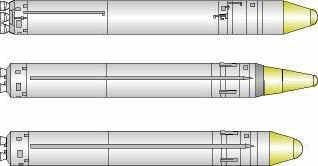Type ICBM Weight 105.6 tonnes | In service 1975–present | |
 | ||
Manufacturer Khrunichev Machine-Building Plant | ||
The UR-100N is an intercontinental ballistic missile in service with Soviet and Russian Strategic Rocket Forces. The missile was given the NATO reporting name SS-19 Stiletto and carries the industry designation 15A30.
Contents
Development
Development of the UR-100N began at OKB-52 in 1970 and flight tests were carried out from 1973 through 1975. In 1976, the improved UR-100NUTTKh (SS-19 Mod 3) version entered development with flight tests in the later half of the decade. The rocket's control system was developed at NPO "Electropribor" (Kharkiv, Ukraine).
Description
The UR-100N is a fourth-generation silo-launched liquid-propellant ICBM similar to the UR-100 but with much increased dimensions, weights, performance, and payload. The missile was not designed to use existing UR-100 silos, and therefore had new silos constructed for it.
The missile has a preparation time to start of 25 minutes, a storage period of 22 years, and 6 MIRVs
Operational history
The UR-100N reached initial operating capability in 1974, and by 1978 an inventory of 190 launchers were reached. In 1979, the UR-100UTTKh became operational and by 1983 had replaced many older missiles and reached maximum inventory of 360 launchers. This had fallen to 300 by 1991, and with the dissolution of the Soviet Union, many in Ukraine became property of that nation. 170 remained in Russia, although treaty obligations required the rearming of the missiles with single warheads. Russia retains 30 UR-100UTTKhs in its inventory with the potential to retain as many as fifty by the end of the decade. Recent political developments have led to plans to rearm the missiles again with MIRV warheads.
The units previously held by Ukraine have been returned to Russia or decommissioned.
As of 2013, the Russian Strategic Rocket Forces had an estimated 35 SS-19s in service.
The UR-100N forms the basis of the Rockot space launch system, which was used in several successful launches in the 1990s and early 2000s (decade), and one failed launch of the ESA CryoSat satellite in 2005. After the failure, Rockot launches were suspended. Once the cause was unambiguously identified and corrective measures implemented, Rockot returned to active service on 28 July 2006, with the successful launch of an earth observation satellite for South Korea.
